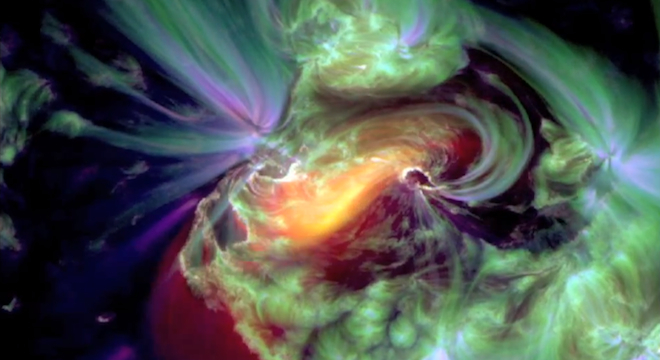The Sun has it out for us. Or at least, one particularly active region of the sun, AR1504, seems as though it does.
Over the past week, the region has spewed five different solar flares and associated coronal mass ejections — blasts of charged, radioactive particles that can cause interference with telecommunications and the electrical grid when they strike Earth, as well as spectacular Northern Lights displays.
Two flares that occurred on Wednesday and Thursday, respectively, each produced coronal mass ejections that are both expected to strike Earth on Saturday, June 16th. Fortunately, NASA scientists don’t believe the effects will be quite so dramatic this time around.
“A strong geomagnetic storm can lead to disruptions to communications and electrical grid systems, but it does not appear that either storm from the last two days will cause a strong storm,” wrote Rebekah Evans, a scientist at NASA’s Goddard Space Flight Center in Greenbelt, Maryland, in an email to TPM. “We will be monitoring these events closely.”
Here’s a close-up video of the hyperactive solar region on June 12, published by NASA’s Solar Dynamics Observatory, the name of an orbital spacecraft tracking the Sun right now and also the NASA mission supporting it.
“It’s one of those regions that are fun to observe and share via social media – because it highlights how active our star is,” said Romeo Durscher, the video’s producer and a Stanford University research administrator, of AR1504.
The flare that erupted on Wednesday over the course of three hours was an M-class, or the second most powerful on solar scientists five-letter scale for classifying the intensity of the events (each flare also gets a number from one through nine before it can move up the scale to the next lettered level of intensity, except for X, which has no limit).
But Wednesday’s flare, an M1, produced a coronal mass ejection traveling at 372 miles per second (1.34 million miles per hour). While that seems incomprehensibly fast to us Earthbound travelers, the particle blast is actually “not extremely high,” according to Evans, “and so its effect is expected to be small.”
Another M-class flare erupted on Thursday along with another coronal mass ejection, and “this one appears to be stronger,” Evans told TPM, which could “result in a moderate geomagnetic storm.”
The active region itself, AR1504, rotated into Earth’s view on June 9 and was detected by NASA’s twin orbital unmanned STEREO spacecraft.
Check out a video of AR1504 beginning from when NASA’s Solar Dynamics Observatory first caught sight of it:
Although AR1504 is likely to rotate out of Earth’s view in about seven days, the activity on the Sun is actually poised to intensify over the next year, as the Sun approaches solar maximum in 2013, the apex of its regular 11-year activity cycle.
“Right now the Sun is entering the most active time in the solar cycle, which means there are more sunspots and complex magnetic structures,” Evans wrote. “As a result, we see an increase in the number of strong flares and coronal mass ejections. Since January, there have been three X-class, or extreme, flares. The peak of solar activity is expected to occur sometime in 2013, so we can look forward to a lot of interesting solar events in the next year.”






